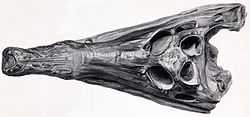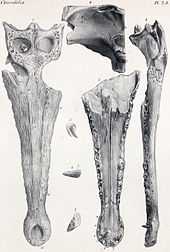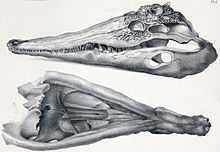Kentisuchus
| Kentisuchus Temporal range: Early Eocene | |
|---|---|
 | |
| K. toliapicus skull | |
| Scientific classification | |
| Kingdom: | Animalia |
| Phylum: | Chordata |
| Class: | Reptilia |
| Superorder: | Crocodylomorpha |
| Order: | Crocodilia |
| Subfamily: | Tomistominae |
| Genus: | †Kentisuchus Mook, 1955 |
| Species | |
| |
Kentisuchus is an extinct genus of tomistomine crocodylian. It is considered one of the most basal members of the subfamily. Fossils have been found from England that date back to the early Eocene. There is also evidence that suggests that the genus was also present in Ukraine at the time, although material found from the Ukrainian locality cannot be referred to any particular species.[1]
Species

The genus Kentisuchus was constructed by Charles Mook in 1955 as a replacement name for the basal tomistomine "Crocodylus" spenceri, named by William Buckland in 1836.[2][3] Buckland named "Crocodylus" spenceri on the basis of a partial skull found from the Isle of Sheppey in Kent, England. Another tomistomine known as "Crocodylus" toliapicus was later described by Richard Owen, who considered it synonymous with “Crocodylus” spenceri yet kept the new name. In 1888 Richard Lydekker considered "C." toliapicus synonymous with two other known crocodilians, "C." champsoides, named by Owen, and "C." arduini, named by De Zigno, and reapplied the name "C." spenceri to all of these species.[4][5]
The genus name Kentisuchus was constructed only after it was realized that these tomistomine specimens were clearly distinct from the genus Crocodylus and that some specimens originally assigned to "C." spenceri belonged to entirely different genera and species. "C." arduini was reassigned to the new genus Megadontosuchus in the same paper that Kentisuchus was first described in. "C." toliapicus and "C." champsoides were both found to be species of Kentisuchus, the former being considered the type species. "C." spenceri has provisionally been referred to Kentisuchus as well.[6]
Phylogenetics
K. spenceri may be congeneric with M. arduini and Dollosuchus dixoni, according to several more recent studies.[7][8] If this is the case then the name Dollosuchus has seniority over the other two, although it is likely the three taxon will remain their own distinct species.[9] Other recently conducted phylogenetic analyses suggest that K. spenceri is closely related to Dollosuchus.[10][11] An apparent close relationship between K. spenceri and Eosuchus lerichei has been used to imply that the latter species was a tomistomine, while it is now thought that Eosuchus is a basal gavialoid that is crownward to most other members of the superfamily.[12][13][14]
Paleobiology

The close relation of Kentisuchus and Dollosuchus, which are known from European localities that were on the mainland during the early Eocene, to Megadontosuchus, which is known from Italian localities that were once part of a Tethysian archipelago, suggests that it came to these islands after a tomistomine dispersal event south from mainland Europe rather than north from Africa.[15]
References
- ↑ Efimov, M. B. (1993). The Eocene crocodiles of the GUS — a history of development. Kaupia 3:23–25.
- ↑ Mook, C. C. (1955). Two new genera of Eocene crocodilians. American Museum Novitates 1727:1-4.
- ↑ Buckland, W. (1836). Geology and Mineralogy Considered with Reference to Natural Theology. 618 pp. Pickering, London.
- ↑ De Zigno, A. (1880). Sopra un cranio di coccodrillo scoperto nel terreno Eoceno del Veronese. Mem. R. Accad. Lincei, ser. 3, Cl. Sci. Fip., Mat., Nat., vol. 5, pp. 65-72.
- ↑ Lydekker, R. (1888). Catalogue of the fossil Reptilia in the British Museum. London, pp. 60-63.
- ↑ Brochu, C. A. (2007). Systematics and taxonomy of Eocene tomistomine crocodylians from Britain and Northern Europe. Palaeontology 50(4):917-928
- ↑ Brochu, C. A. (1997). Phylogenetic Systematics and Taxonomy of Crocodylia. Unpublished Ph.D. thesis. 467 pp. University of Texas, Austin.
- ↑ Brochu, C. A. (2001). Congruence between physiology, phylogenetics, and the fossil record on crocodylian historical biogeography. In: Grigg, G., Seebacher, F., and Franklin, C. E., eds., Crocodilian Biology and Evolution, pp. 9–28. Surrey Beatty and Sons, Sydney.
- ↑ Piras, P., Delfino, M., Del Favero, L., and Kotsakis, T. (2007). Phylogenetic position of the crocodylian Megadontosuchus arduini and tomistomine palaeobiogeography. Acta Palaeontologica Polonica 52(2):315–328.
- ↑ Jouve, S. (2004). Etude des crocodyliformes fini Crétace−Paléogène du Bassin de Oulad Abdoun (Maroc) et comparaison avec les faunes africaines contemporaines: systématique, phylogénie et paléobiogéographie. Ph.D. thesis. 652 pp. Muséum National d’Histoire Naturelle de Paris, Paris.
- ↑ Delfino, M., Piras, P., and Smith, T. (2005). Anatomy and phylogeny of the gavialoid crocodylian Eosuchus lerichei from the Paleocene of Europe. Acta Palaeontologica Polonica 50:565–580.
- ↑ Brochu, C. A. (1997). Phylogenetic Systematics and Taxonomy of Crocodylia. Unpublished Ph.D. thesis. 467 pp. University of Texas, Austin.
- ↑ Brochu, C. A. (2001). Crocodylian snouts in space and time: phylogenetic approaches toward adaptive radiation. American Zoologist 41:564–585.
- ↑ Delfino, M., Piras, P., and Smith, T. (2005). Anatomy and phylogeny of the gavialoid crocodylian Eosuchus lerichei from the Paleocene of Europe. Acta Palaeontologica Polonica 50(3):565–580.
- ↑ Kotsakis, T., Delfino, M., and Piras, P. (2004). Italian Cenozoic crocodilians: taxa, timing and palaeobiogeographic implications. Palaeogeography, Palaeoclimatology, Palaeoecology 210(1):67-87.
External links
- Kentisuchus in the Paleobiology Database